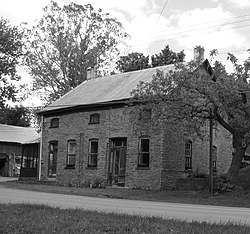Kort Grocery | |
 Kort Grocery | |
| Location | Four Mile Pike, Camp Springs, Kentucky |
|---|---|
| Coordinates | 39°0′1″N84°21′49″W / 39.00028°N 84.36361°W |
| Built | 1880 |
| Built by | Peter Kort |
| MPS | German Settlement, Four Mile Creek Area TR |
| NRHP reference No. | 83002606 [1] |
| Added to NRHP | March 9, 1983 |
Kort Grocery, also known as Camp Springs Grocery, is a historic property located on Four Mile Road in Camp Springs, Kentucky, a rural area of Campbell County, Kentucky. The stone building was constructed by Peter Kort in 1880 as part of a settlement built by German immigrants. The structure was added to the United States National Register of Historic Places in 1983. [1]
It was built as a grocery store. It is a 1+1⁄2-story stone commercial store and residence built along a hillside. Its five-bay front faces Four Mile Pike. [2]

